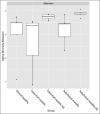Association of milk microbiome with bovine mastitis before and after antibiotic therapy
- PMID: 38328355
- PMCID: PMC10844787
- DOI: 10.14202/vetworld.2023.2389-2402
Association of milk microbiome with bovine mastitis before and after antibiotic therapy
Abstract
Background and aim: Mastitis is recognized as the most common disease in cattle and causes economic losses in the dairy industry. A number of opportunistic bacterial taxa have been identified as causative agents for this disease. Conventionally, antibiotics are used to treat mastitis; however, most bacteria are resistant to the majority of antibiotics. This study aimed to use molecular methods to identify milk microbiome patterns characteristic of mastitis that can help in the early diagnosis of this disease and in the development of new treatment strategies.
Materials and methods: To evaluate the microbiome composition, we performed NGS sequencing of the 16S rRNA gene of the V3 region.
Results: An increase in the abundance of the bacterial genera Hymenobacter and Lachnospiraceae NK4A136 group is associated with the development of subclinical and clinical mastitis in dairy cows. These bacteria can be added to the list of markers used to detect mastitis in cows. Furthermore, a decrease in the abundance of Ralstonia, Lachnospiraceae NK3A20 group, Acetitomaculum, Massilia, and Atopostipes in cows with mastitis may indicate their role in maintaining a healthy milk microbiome. Antibiotics reduced the levels of Streptococcus in milk compared to those in the healthy group and cows before antibiotic treatment. Antibiotic therapy also contributed to an increase in the abundance of beneficial bacteria of the genus Asticcacaulis.
Conclusion: This study expands our understanding of the association between milk microbiota and mastitis.
Keywords: cattle; dairy industry; early diagnosis; microbiome.
Copyright: © Burakova, et al.
Conflict of interest statement
The authors declare that they have no competing interests.
Figures









References
-
- Diptimayee A, Puspanjali P, Himansu S.M, Santi L.S, Jyoti R.R. Bovine mastitis:Causes and phytoremedies. J. Pure Appl. Microbiol. 2022;16(4):2259–2269.
-
- Heikkilä A.M, Liski E, Pyörälä S, Taponen S. Pathogen-specific production losses in bovine mastitis. J. Dairy Sci. 2018;101(10):9493–9504. - PubMed
-
- Alvaro G. Contagious vs. Environmental Mastitis. Semantic Scholar. Extension Extra. Paper. 126. 2004
LinkOut - more resources
Full Text Sources
